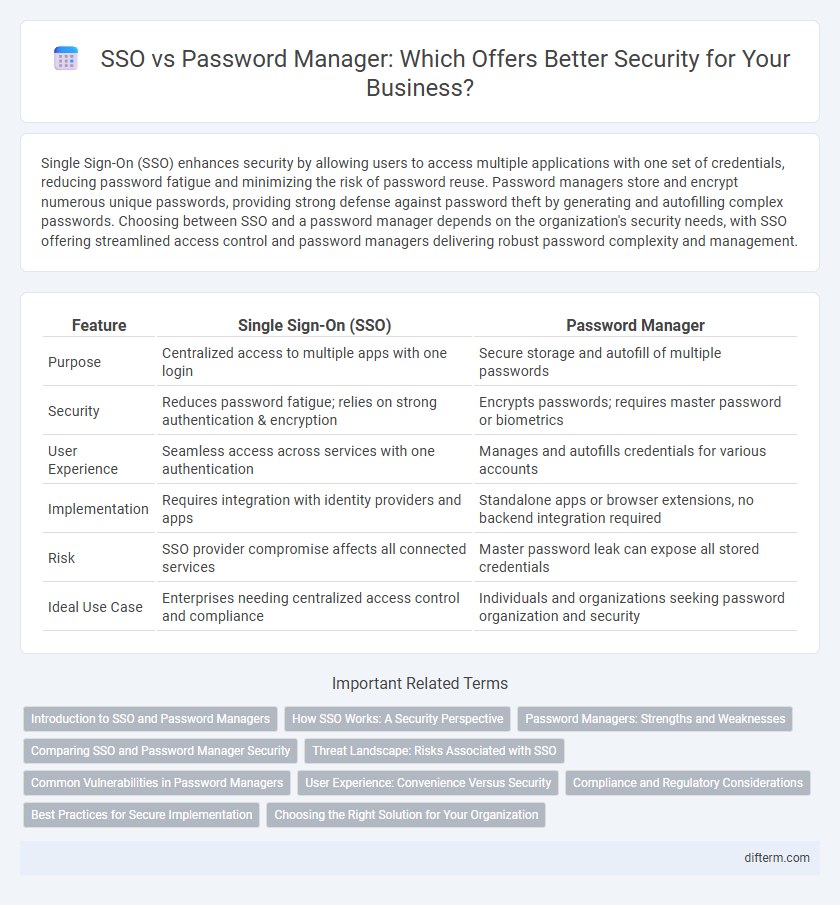Single Sign-On (SSO) enhances security by allowing users to access multiple applications with one set of credentials, reducing password fatigue and minimizing the risk of password reuse. Password managers store and encrypt numerous unique passwords, providing strong defense against password theft by generating and autofilling complex passwords. Choosing between SSO and a password manager depends on the organization's security needs, with SSO offering streamlined access control and password managers delivering robust password complexity and management.
Table of Comparison
| Feature | Single Sign-On (SSO) | Password Manager |
|---|---|---|
| Purpose | Centralized access to multiple apps with one login | Secure storage and autofill of multiple passwords |
| Security | Reduces password fatigue; relies on strong authentication & encryption | Encrypts passwords; requires master password or biometrics |
| User Experience | Seamless access across services with one authentication | Manages and autofills credentials for various accounts |
| Implementation | Requires integration with identity providers and apps | Standalone apps or browser extensions, no backend integration required |
| Risk | SSO provider compromise affects all connected services | Master password leak can expose all stored credentials |
| Ideal Use Case | Enterprises needing centralized access control and compliance | Individuals and organizations seeking password organization and security |
Introduction to SSO and Password Managers
Single Sign-On (SSO) enables users to access multiple applications with one set of credentials, enhancing security by reducing password fatigue and minimizing login-related vulnerabilities. Password managers store and encrypt complex passwords, allowing users to generate, retrieve, and autofill unique passwords securely for each account. Both tools improve cybersecurity but address different aspects of credential management and authentication processes.
How SSO Works: A Security Perspective
Single Sign-On (SSO) centralizes authentication by allowing users to access multiple applications with one set of credentials, reducing password-related security risks such as reuse and phishing. SSO leverages secure token exchange protocols like SAML, OAuth, or OpenID Connect, which enforce strong identity verification and reduce attack surfaces. The centralized authentication mechanism supports better monitoring and incident response, enhancing overall security posture compared to decentralized password management systems.
Password Managers: Strengths and Weaknesses
Password managers offer strong encryption methods to securely store and autofill complex passwords, significantly reducing the risk of password reuse and phishing attacks. They provide centralized control for managing credentials across multiple accounts, enhancing user convenience and security hygiene. However, if a password manager's master password is compromised, it can expose all stored credentials, and reliance on a single platform introduces potential risks related to software vulnerabilities or data breaches.
Comparing SSO and Password Manager Security
Single Sign-On (SSO) centralizes authentication, reducing password fatigue and minimizing attack vectors, but it creates a single point of failure if the primary credentials are compromised. Password managers store and encrypt multiple passwords, enhancing security through complex, unique passwords for each account, yet they rely heavily on the master password's strength and the security of the password manager itself. Organizations often balance SSO's streamlined access control with password managers' granular security to optimize overall protection against credential theft and unauthorized access.
Threat Landscape: Risks Associated with SSO
Single Sign-On (SSO) centralizes access, which creates a high-value target for attackers aiming to compromise multiple systems through one credential set, increasing the risk of credential theft and lateral movement within the network. Phishing attacks, token theft, and misconfigurations in SSO implementations can expose sensitive data and lead to widespread breaches. Unlike password managers, which store encrypted passwords locally or in the cloud, SSO's reliance on identity providers introduces dependency risks and potential single points of failure in the authentication process.
Common Vulnerabilities in Password Managers
Password managers often face common vulnerabilities such as phishing attacks, malware exploitation, and weak master password protection, which can lead to unauthorized access and data breaches. Unlike Single Sign-On (SSO) systems that centralize authentication with multi-factor support, password managers store large volumes of sensitive credentials, increasing the risk surface if compromised. Regular security audits, end-to-end encryption, and hardware-based authentication are critical to mitigating these vulnerabilities in password management solutions.
User Experience: Convenience Versus Security
Single Sign-On (SSO) enhances user convenience by allowing access to multiple applications with one set of credentials, reducing login fatigue but increasing reliance on a single authentication point. Password managers improve security through strong, unique passwords for each account but may require more user interaction and longer setup times. Balancing convenience and security depends on organizational needs, where SSO simplifies access while password managers offer granular control over credential protection.
Compliance and Regulatory Considerations
Single Sign-On (SSO) simplifies compliance by centralizing access control and enhancing audit trails, facilitating adherence to regulations like GDPR, HIPAA, and SOX. Password managers offer granular password management but pose challenges in regulatory environments requiring strict access logging and multi-factor authentication enforcement. Organizations aiming for compliance often prefer SSO solutions integrated with identity governance frameworks to meet regulatory mandates efficiently.
Best Practices for Secure Implementation
Implementing Single Sign-On (SSO) securely requires strong authentication protocols like SAML or OAuth coupled with multi-factor authentication (MFA) to mitigate unauthorized access risks. Password managers should enforce encryption standards such as AES-256 and support zero-knowledge architecture to protect stored credentials from breaches. Combining SSO with password managers enhances security by reducing password reuse and simplifying credential management while ensuring compliance with cybersecurity best practices.
Choosing the Right Solution for Your Organization
Choosing the right solution between SSO (Single Sign-On) and password managers depends on your organization's security needs and user experience priorities. SSO centralizes authentication, reducing password fatigue and simplifying access management, while password managers securely store and generate complex passwords without the need for a centralized system. Evaluating factors such as scalability, compliance requirements, and integration capabilities ensures selecting a solution that enhances security posture and operational efficiency.
SSO vs Password manager Infographic

 difterm.com
difterm.com